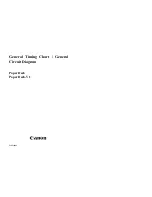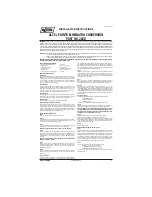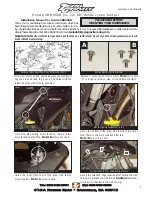
Refrigeration Service Procedures
140
4. Turn the unit Off.
5. Front seat the suction service valve to isolate
the low side while it is still in a vacuum.
6. Watch the low pressure gauge attached to the
suction access port. The low side pressure
should not rise. It it does, there could be a leak
through one (or more) of following
components: hot gas solenoid, liquid injection
solenoid, purge valve, or receiver tank
pressure check valve.
7. Check the temperatures of the refrigeration
lines on each side of the PV by hand. A
temperature difference between the two sides
of the PV indicates it is leaking.
8. Use the Mechanics/Premium HMI Control
Panel to enter the Interface Board Test Mode.
Refer to the appropriate Microprocessor
Diagnostic Manual for specific information
about the Interface Board Test Mode.
9. From the Interface Board Test Mode select
Purge Valve.
10. Momentarily (for approximately 1 second)
energize the PV with the Interface Board Test
Mode. The low side pressure should rise
slightly. If the low side pressure does not rise,
the PV is not opening. Check the continuity of
the wiring and the solenoid coil before
assuming the solenoid is faulty.
11. Back seat the receiver tank outlet valve and
the suction service valve. Perform a
“Refrigerant Gauge Removal” procedure.
Receiver Tank Pressure Check
Valve Test
1. Attach a gauge manifold to the suction service
valve and the discharge service port. Attach
another low pressure gauge to the suction
access port located in the suction line near the
accumulator inlet. Low loss fittings must be
used on the hoses connected to the discharge
service port and the suction access port.
2. Operate the unit in low speed cool.
3. Front seat the receiver tank outlet valve and
allow the low side to pump down to 0 to 5 in.
Hg vacuum (0 to -17 kPa).
4. Turn the unit Off.
5. Front seat the suction service valve to isolate
the low side while it is still in a vacuum.
6. Watch the low pressure gauge attached to the
suction access port. The low side pressure
should not rise. It it does, there could be a leak
through one (or more) of following
components: hot gas solenoid, liquid injection
solenoid, purge valve, or receiver tank
pressure check valve.
7. Check the temperatures of the refrigeration
lines on each side of the receiver tank pressure
check valve by hand. A temperature
difference between the two sides of the
receiver tank pressure check valve indicates it
is leaking.
8. Back seat the receiver tank outlet valve and
the suction service valve, and remove the
gauges to return the unit to normal operation.
Receiver Tank Replacement
Removal
1. Recover the refrigerant charge.
2. Unsolder the inlet tube from the receiver tank.
3. Unsolder the filter drier line from the receiver
tank outlet valve.
4. Unbolt the mounting brackets and remove the
receiver tank from the unit.
Installation
1. Place the receiver tank in the unit and install
the mounting bolts and nuts loosely. Position
the receiver tank so the sight glass is clearly
visible and the outlet tube lines up.
2. Solder the inlet tube from condenser check
valve tube to the receiver tank.
3. Solder the filter drier line to the receiver tank
outlet valve.
CAUTION: Do not run scroll compressor
in a vacuum for more than 1 minute.
CAUTION: Do not run scroll compressor
in a vacuum for more than 1 minute.
Summary of Contents for UT-1200
Page 10: ...Table of Contents 10...
Page 20: ...Safety Precautions 20...
Page 76: ...Operating Instructions for Premium HMI Control Panel 76...
Page 88: ...Electrical Maintenance 88...
Page 98: ...Engine Maintenance 98 Figure 167 Fuel Components...
Page 142: ...Refrigeration Service Procedures 142...
Page 148: ...Clutch Maintenance 148...
Page 150: ...Structural Maintenance 150...
Page 162: ...Wiring and Schematic Diagrams Index 162...
Page 163: ...163 Schematic Diagram Page 1 of 2...
Page 164: ...164 Schematic Diagram Page 2 of 2...
Page 165: ...165 Wiring Diagram Page 1 of 5...
Page 166: ...166 Wiring Diagram Page 2 of 5...
Page 167: ...167 Wiring Diagram Page 3 of 5...
Page 168: ...168 Wiring Diagram Page 4 of 5...
Page 169: ...169 Wiring Diagram Page 5 of 5...
















































